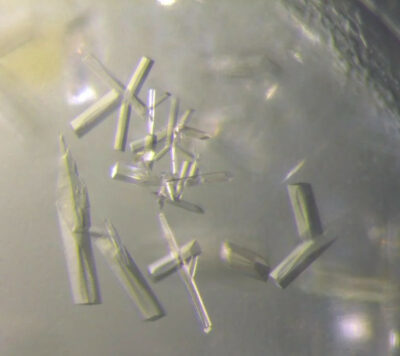Viral Gene Products May Contribute to Soil Carbon Cycling
09/19/2022

Soil Virus Gene Products Visualized. Crystals of a soil virus chitosanase are shown at 400x magnification. Individual crystals were cryo-cooled in liquid nitrogen before being exposed to powerful SSRL X-ray beams for structure analysis. [Clyde Smith/SLAC National Accelerator Laboratory]
The Summary
Metagenomics is unearthing the previously hidden world of soil viruses. Many soil viral sequences in metagenomes contain putative auxiliary metabolic genes (AMGs) unassociated with viral replication. Using X-ray macromolecular crystallography to visualize the atomic structure of proteins expressed by several viral AMGs, scientists established that the proteins are in fact functional and active.
The researchers expressed and functionally screened AMGs that potentially encode chitosanase enzymes that metabolize chitin—an abundant soil carbon polymer found in insect exoskeletons and fungal cell walls. One expressed protein showing endo-chitosanase activity, called viral chitosanase (V-Csn), was crystalized and structurally characterized at ultra-high resolution. Specifically, researchers irradiated fragile crystallized protein samples with high-brightness X-rays generated by the Stanford Synchrotron Radiation Lightsource (SSRL) beamline 12-2.
The V-Csn structure provides details about its active site and, together with structure models determined using the protein structure prediction software AlphaFold, facilitates understanding of substrate specificity and enzyme mechanism. The findings support the hypothesis that soil viruses contribute auxiliary functions to their hosts and may play a role in critical soil processes like chitin decomposition and carbon cycling.
Related Links
- BER Resource: Structural Molecular Biology Resource
- SLAC News: Mysterious Soil Virus Gene Seen for First Time
References
Wu et al. 2022. Structural Characterization of a Soil Viral Auxiliary Metabolic Gene Product—A Functional Chitosanase. Nature Communications 13, 5485. [DOI: 10.1038/s41467-022-32993-8]
